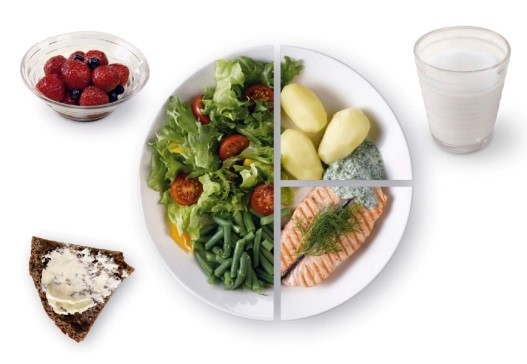Dietary advice in relation to prevention of AD and cognitive impairment
One of the aims of LIPIDIDIET was to develop a healthy diet index and dietary advice in relation to prevention of AD and cognitive impairment. The CAIDE Healthy Diet Index was developed based on data from a longitudinal population-based study in Finland, Cardiovascular Risk factors, Aging and Dementia (CAIDE). People who had a diet rich in vegetables and fruits, fibers, fish, unsaturated fats, drank coffee, drank alcohol only moderately, and consumed less meat, saturated fats, and food products with high contents of salt or carbohydrates (e.g. sugar, sweet soft drinks, and candies) were less likely to develop dementia and Alzheimer’s disease.
The dietary patterns identified in the CAIDE study as protective against dementia were very similar to general healthy dietary patterns recommended by the National Nutrition Council in Finland or the World Health Organization (WHO). The WHO has previously emphasized that a healthy diet can protect against malnutrition in all its forms, as well as chronic diseases including diabetes, heart disease, stroke and cancer.
Results from observational studies in the LIPIDIDIET project also suggest that vitamins B12, E and D are associated with protection against dementia, cognitive impairment and related brain changes. It is important to note that our studies on vitamins focused on their blood levels, not on vitamin intake from diet or from vitamin supplements. While vitamin deficiencies seem to have detrimental effects on the risk of dementia, we cannot make any specific recommendations about vitamin supplements in relation to dementia. A healthy individual with a balanced diet should get the necessary vitamins from dietary components. However, vitamin deficiencies can be common at older ages or in people with diseases affecting the uptake of vitamins from diet. Because vitamin deficiencies are related to a variety of health problems (not just dementia), it is important that vitamin deficiencies are diagnosed during medical check-ups, so that the treating physician can prescribe an adequate vitamin supplementation.
Based on the CAIDE Healthy Diet Index, the Finnish Nutrition and the WHO recommendations, a healthy diet can be achieved by:
- Eating vegetables, fruits and berries frequently (a minimum of 400-500 g/day, excluding potatoes). This can be done by always including vegetables in meals, eating fresh fruits and vegetables as snacks, and by eating a variety of locally available fruits and vegetables.
- Eating a diet rich in fibers, for example wholegrain cereals (bread, porridge, pasta, etc.). Products made of refined flour and rich in saturated fat and sugar should be avoided.
- Concerning dietary fats, saturated fat intake should be decreased in favor of unsaturated fats. Often the amount of saturated, unsaturated and polyunsaturated fat is indicated on the food label. Preferentially food with higher amounts of polyunsaturated fats, especially omega-3 polyunsaturated fat should be chosen. Food with high amounts of saturated fat should be avoided. For example, vegetable oils should be chosen for cooking and salads instead of animal oil. Boiling, steaming or baking the food are preferable to frying it. Processed foods containing trans-fats should be avoided. Vegetable oil, or vegetable oil based spreads can be used on bread instead of butter. The consumption of foods rich in saturated fats (e.g. high-fat cheese, ice cream, fatty meat) should be limited. If milk is consumed, low fat milk should be preferred over high fat milk.
- Eating different types of fish at least two times a week (but paying attention to salty fish).
- Limiting salt consumption (salt intake should be < 5 g/day). According to the WHO, in many countries most of the dietary salt comes from processed foods (e.g. ready meals; processed meats like bacon, ham and salami; cheese and salty snacks) or from food consumed frequently in large amounts (e.g. bread). Salt is also added to food during cooking (e.g. bouillon, stock cubes, soy sauce and fish sauce) or at the table (e.g. table salt). Choosing low-salt products, not adding salt or high-salt sauces to meals, and limiting consumption of salty snacks are ways to reduce salt consumption. Salt can also be replaced by salt-free spices to add more taste to meals.
- Limiting the consumption of red meat and meat products. Low-fat, low-salt products should be chosen when eating meat. Game meat or organically/pasture grown meat often has a preferential fat composition over that from grain fed animals.
- Limiting the consumption of food and drinks with high amounts of sugar (e.g. sweets, candies, and beverages with sugar). Fresh fruits and water can replace sugary snacks and beverages.
- Avoiding excessive alcohol consumption.
- Eating regularly, consuming a variety of healthy food products, learning how to read and understand food product labels, and making sure that energy consumption does not exceed energy expenditure (e.g. avoiding a sedentary lifestyle).
- A good first start into a self-prepared healthy diet could be a cookery book on Mediterranean diet, rich in vegetables, vegetable oils and fish, but low amounts of meat and milk products including cheese.
These recommendations have been made for healthy adults. They may need to be adjusted according to each person’s situation, particularly if the person suffers from any diseases that can affect nutritional status. An assessment by a doctor and a nutritionist is the best way to find out what a healthy diet should include for someone with health problems affecting nutritional status.
The following plate model from the National Nutrition Council in Finland illustrates a balanced meal. Half of the plate should be vegetables, one quarter potatoes (or rice, pasta, or bread), and one quarter should be meat or fish (or eggs, beans or other non-dairy sources of protein). Fresh fruits and berries can be used for desert. Drinking low-fat milk or water is preferable to beverages with high sugar content.
 |
In summary, results from the LIPIDIDIET project emphasize that unhealthy dietary factors at midlife may increase the risk of developing dementia/AD later in life and have a negative effect on several cognitive domains, whereas healthier dietary choices may act in the reverse manner. The current data suggests that healthy dietary choices at midlife may increase the possibility for brain health later in life. Dementia is a complex condition and multiple factors influence the risk during the life course. Diet is only one piece of the puzzle. A healthy diet should be part of a generally healthy lifestyle including also physical activity, cognitive and social activities, and regular medical check-ups (particularly for persons who have chronic cardiovascular, diabetes, and other conditions). The fact that there are several modifiable risk factors for dementia creates a window of opportunity for prevention.

